Vegan Butter Chicken is one of my absolute favorite vegan Indian dishes. It’s so creamy and has the perfect mix of sweet and spicy. The rich sauce layered over perfectly spiced tofu is seriously to die for. I just adore this dish and could easily make it once a week because it’s so easy, hearty, satisfying, and tasty!
There are so many amazing vegan Indian foods to try but if you had to pick one, let it be this one!
Table of Contents
- Where Does Butter Chicken Come From?
- Ingredients Needed
- Substitution Options
- How To Make Vegan Butter Chicken
- What To Serve With Vegan Butter Chicken
- How To Store and Reheat
- FAQ’s
Where Does Butter Chicken Come From?
Butter Chicken is a very popular Indian dish. It’s commonly found in Indian restaurants in North American and is definitely a top favorite for Indian food lovers.
Traditionally, butter chicken is prepared with a gravy sauce that contains butter. Here in this recipe, we’re using good old tofu as our chicken replacement and a delicious sauce made of incredible spices, tomato, onions, garlic, and also cashews to give it that creamy, rich “buttery” flavor that you would find in a traditional Butter Chicken dish.
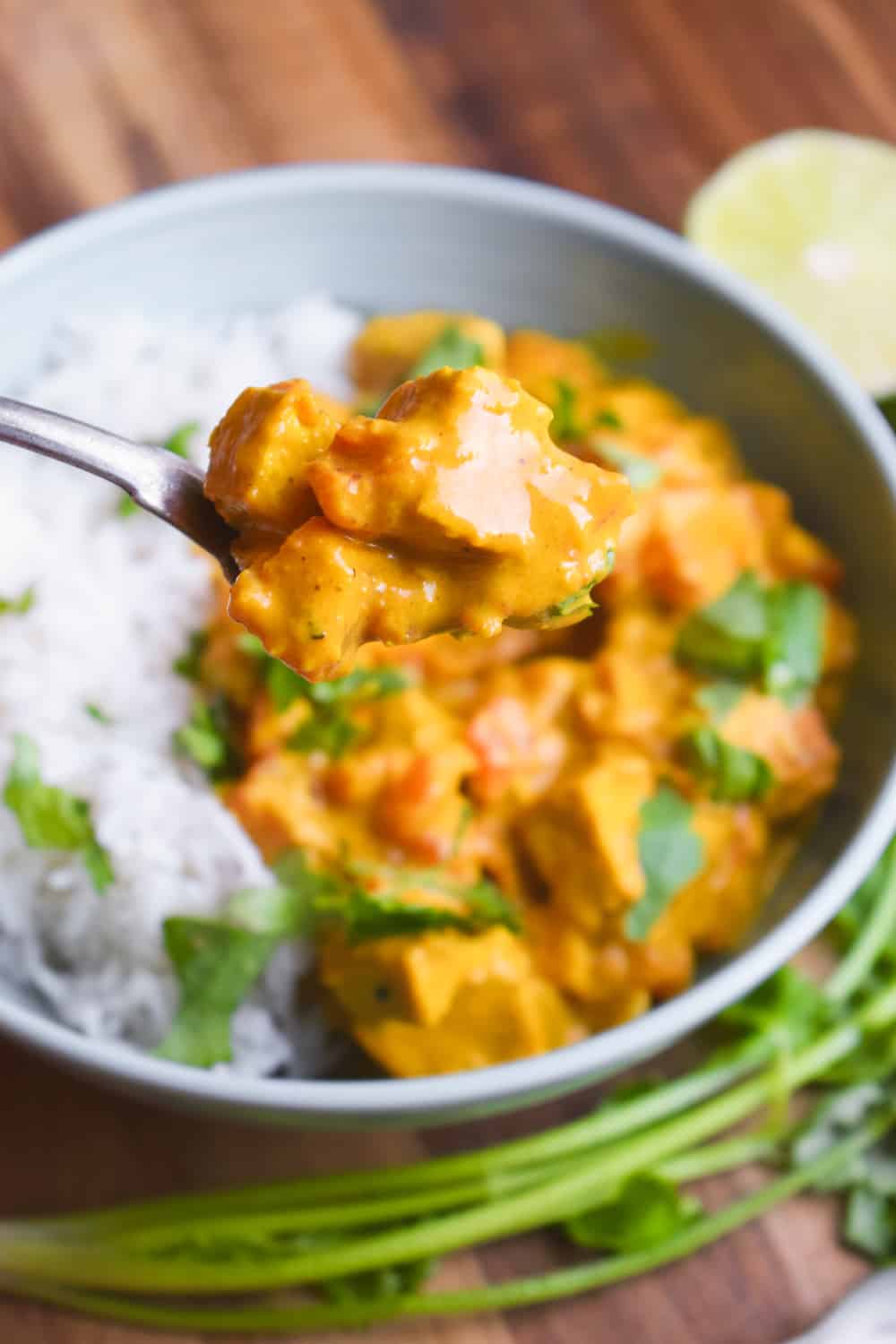
Ingredients Needed
- Tofu: Opt for firm or extra firm tofu to ensure it holds its shape well when cooked. Press the tofu to remove excess moisture before cubing it, which will help it absorb the flavors of the dish.
- Ginger and Garlic: Freshly grated ginger and minced garlic provide aromatic depth to the dish. Adjust the quantities according to your taste preferences for a more pronounced or subtle flavor.
- Lemon Juice: Adds acidity to the dish, enhancing the overall flavor profile.
- Nutritional Yeast: Used for its savory, cheesy flavor, nutritional yeast contributes to the richness of the sauce. It’s a common ingredient in vegan cooking and adds depth to the dish.
- Spices: Paprika, garam masala, and turmeric combine to create the classic flavors of butter chicken.
- Yellow Onion and Tomatoes: These vegetables form the base of the sauce, providing sweetness and acidity. Dicing the tomatoes into small chunks helps them break down more easily during cooking, resulting in a smoother sauce.
- Cashews: Cashews are used to add creaminess and richness to the sauce. It’s our butter placement in this vegan butter chicken recipe. Soaking them before blending helps achieve a smooth texture if you don’t have access to a high-powered blender.
- Sugar: Sugar balances the acidity and spice level. Adjust the sugar quantity based on personal preference for sweetness.

Substitution Options
- If you can’t eat cashews, you can use coconut cream instead!
- If you can’t eat tofu or soy products, you can use chickpeas (like I did with this chickpea and spinach curry) or even jackfruit, and just marinate as instructed and adjust the cooking time as needed. The texture will be completely different but the taste will still be delicious!
- If you like more spice, you can add a red chili into the pan while the onion, garlic, and ginger is sautéing.
How To Make Vegan Butter Chicken
Get ready because your kitchen is going to smell like heaven and your neighbors will be knocking at your door wondering what incredible dish you’re making. The recipe is quite simple and takes no more than 35 minutes to make!
Step 1: You begin making the dish by cutting up your tofu. You can cut it into any shape you like. I like either slicing it into strips or cutting it into little cubes but you can also tear the tofu to help it resemble chicken even more. Any shape works well as long as the pieces aren’t too big. The pieces should be roughly around an inch long.
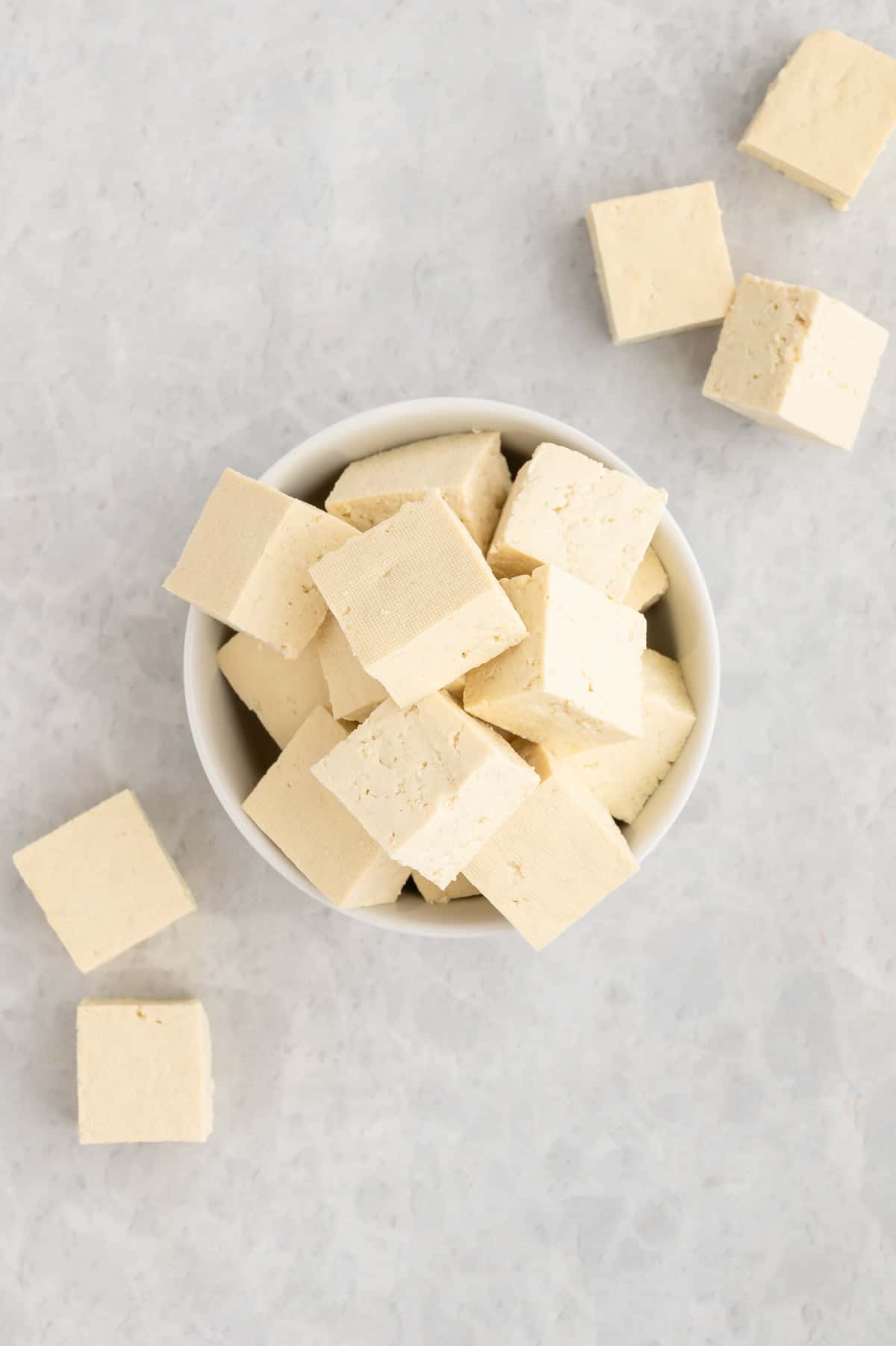
Step 2: Pepare the marinade for the tofu. In a small bowl, simply combine all of the marinade ingredients and whisk well. Then coat the tofu with the marinade so it’s saturated on both sides. If you want to you can actually let the tofu sit and marinate for an hour or longer to really enhance the flavors. However, it’s not necessary and for the sake of convenience, I typically don’t marinate it. The spices are so flavorful and will definitely infuse into the tofu.
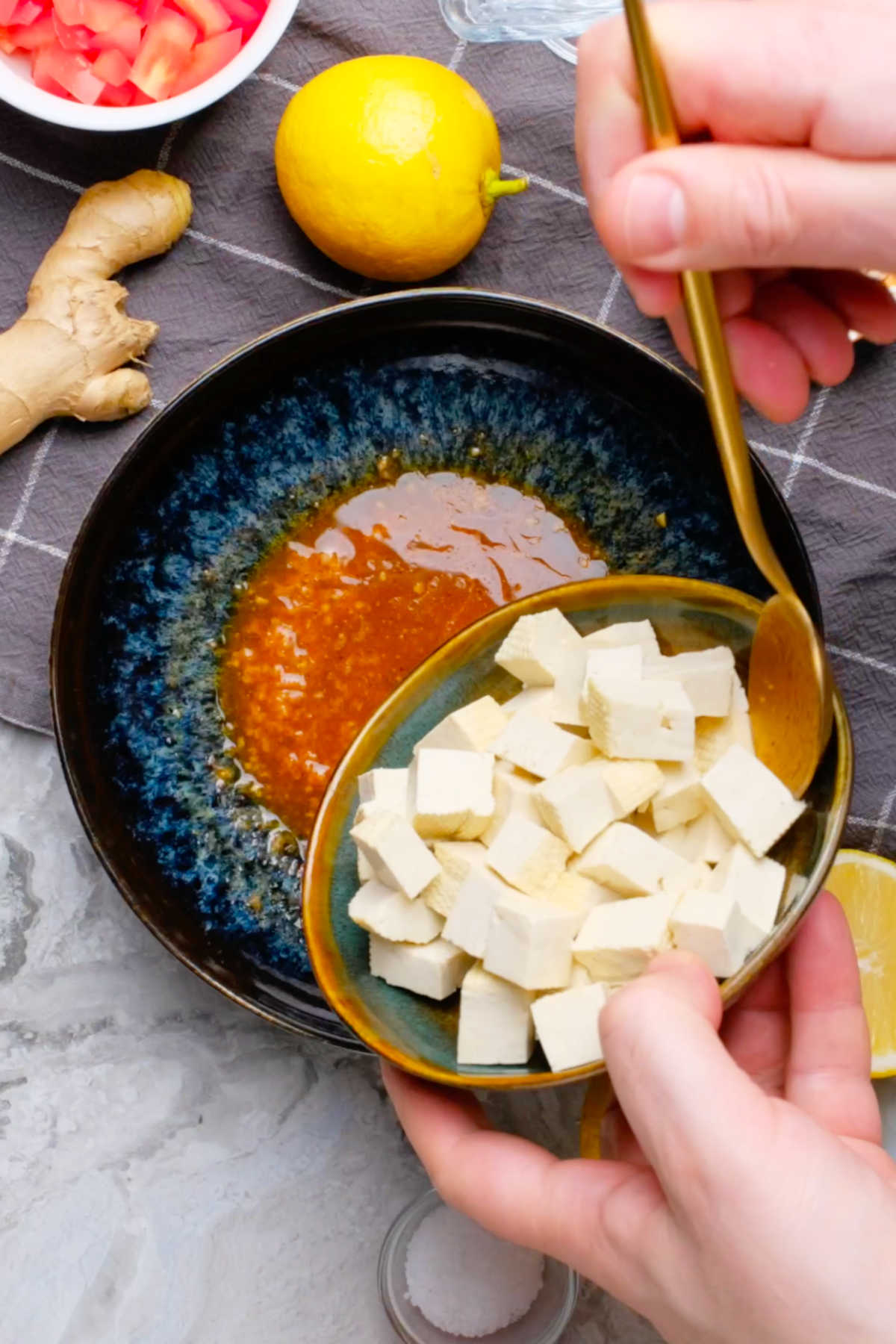
Tip: If you want to save time and meal prep a little bit, you can certainly prepare the tofu ahead of time and just let it sit in your fridge until you’re ready to make the dish! Then once you’re ready to cook the tofu, transfer it to a baking tray and bake it until it is crispy on the outside, but still soft and chewy on the inside.
Step 3: Once you’ve got your tofu in the oven, now you can make the delicious butter chicken sauce. Start by sautéing onions, garlic, and fresh ginger in a large pan. I LOVE fresh ginger and it really makes a huge difference in this dish. If you don’t have fresh ginger, you can use dried ginger to taste instead. Then add the tomatoes and all of the spices and allow this to cook down.

Step 4: You’ll need a high-speed blender (such as a Vitamix) to make the sauce. If you have a blender that’s not quite so powerful, you can still definitely make this recipe, I just suggest soaking the cashews overnight so that they are soft and easy to blend, and then just discard the soak water before blending.
Add water and the cashews to the blender and blend until it’s as smooth as can be. Then transfer the sauce from the pot into the blender. You’ll want to blend it on low speed, just for about 30 seconds. This will gently combine the mixtures to create a sauce with a lovely texture. You don’t want to blend it until it’s perfectly smooth because the sauce will lack texture and be a little thin.
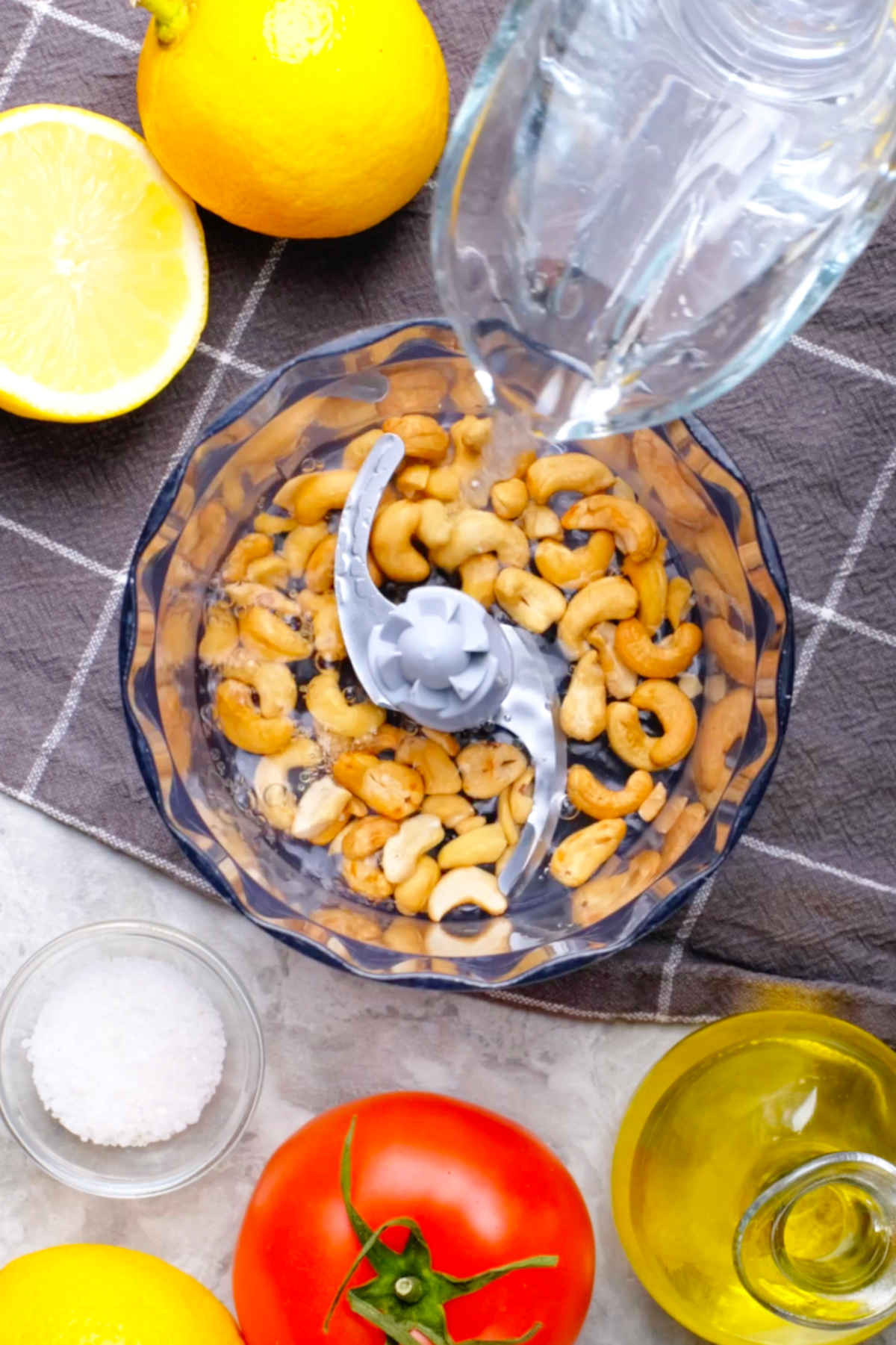
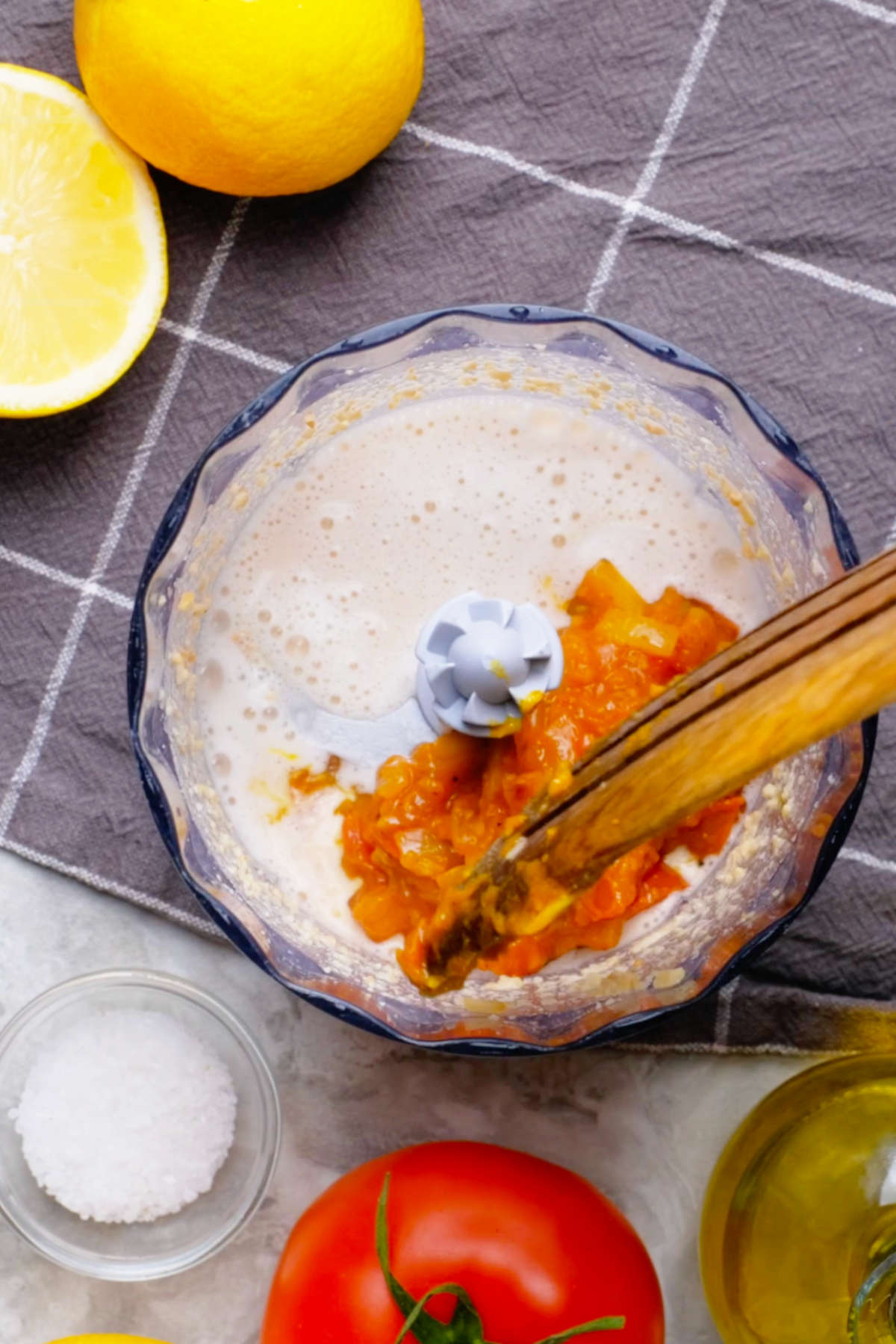
Step 5: Next, transfer the sauce back to the pan and cook it gently for about 5 minutes. This will allow it to thicken nicely and infuse the flavors even more. Add sugar, salt, and pepper to taste. If you’d like, you can use coconut sugar which is a lovely, low glycemic sweetener that compliments this dish extremely well.
The sugar really balances out the spices and creates a delicious sweet and spicy finished product. I usually add 2 tablespoons, but you can add the sugar a little at a time until it suits your taste. Now at this time, you can add any additional spices if needed, to taste.
Step 6: By this time, the tofu should definitely be finished. Remove the baking tray with tofu from the oven and transfer the tofu to the pot. Mix together, and you have your vegan butter chicken!
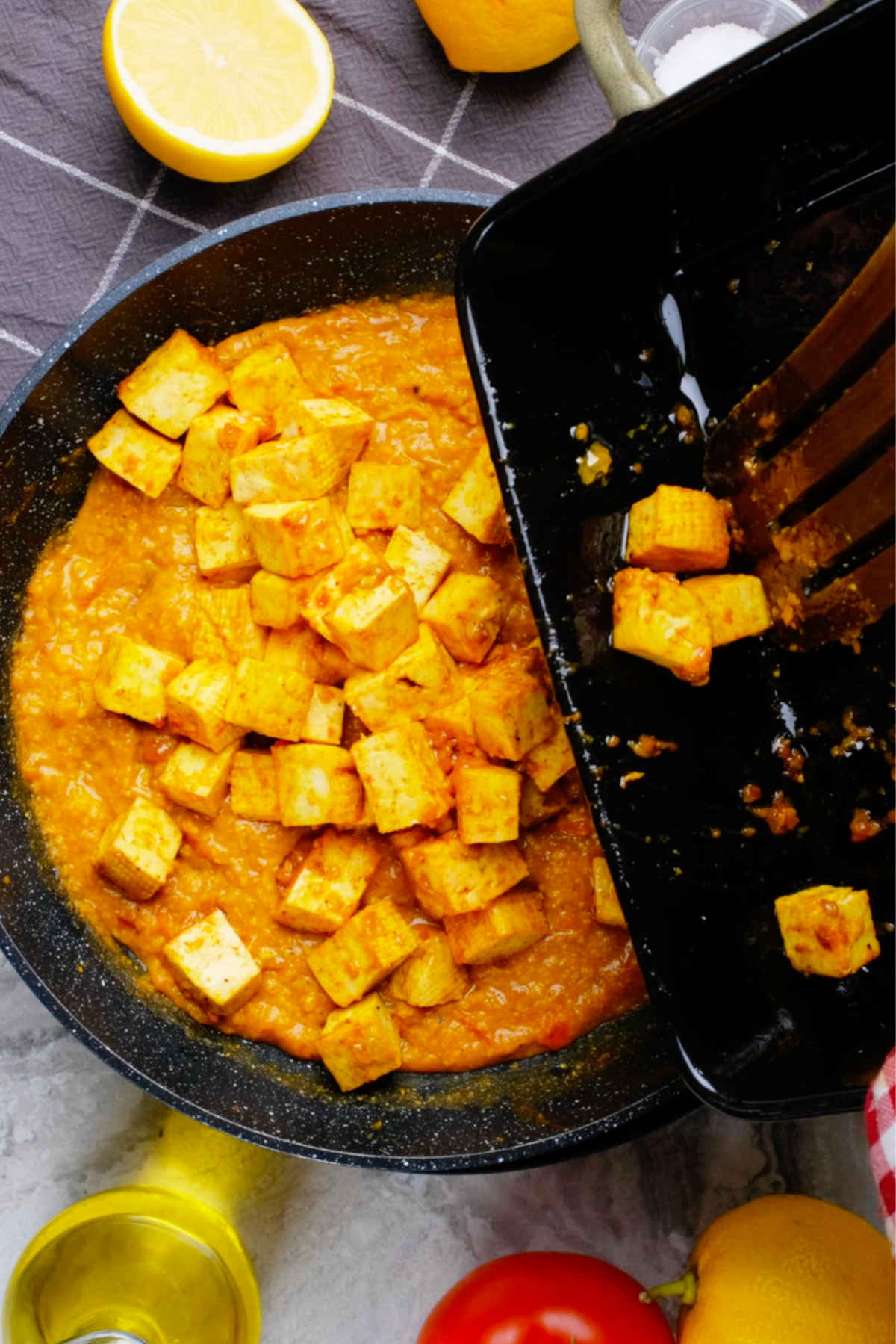
What To Serve With Vegan Butter Chicken
Now you can serve this any way you like it, but I love it served over basmati rice, which is typically used in Indian dishes, along with cilantro for garnish. If you want to make the flavors in this dish pop even more, you could prepare coconut rice which is simply rice cooked with a little bit of coconut milk. It is divine and compliments this dish so well. Another option is to serve this dish with naan and roti, which are traditional Indian breads that can be eaten on the side!
Tip: I suggest making the rice after the tofu goes into the oven. Just set it in the stove to cook and then you can make your sauce.
Alternatively, you can serve the butter chicken on a bed of brown rice, millet, quinoa, or another grain. Note that if you use brown rice, it typically takes longer (around an hour or less) to cook, so just keep that in mind for when you’re planning this dish. Also, if you like to eat grain-free, quinoa is technically a seed, and it’s completely grain and gluten-free. So this is most definitely an alternative for grain-free eaters!
Need some more veggie side dishes? Tindora (ivy gourd) makes an excellent vegetable side or try this creamy Toor Dal soup!
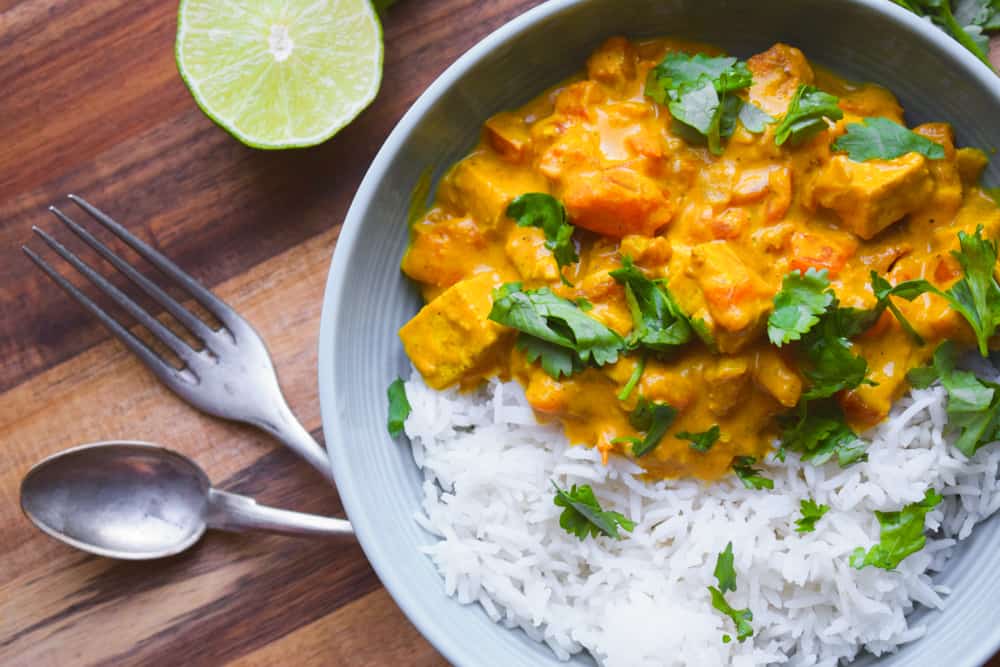
How To Store and Reheat
Transfer any leftovers to an airtight container and refrigerate for up to 4 days. For longer storage, place the vegan butter chicken in a freezer-safe container and store it in the freezer for up to 3 months. Thaw in the refrigerator overnight before reheating.
When reheating, you can use the stovetop or micraove:
- Stovetop: Transfer butter chicken to a saucepan and reheat over medium heat, stirring occasionally to prevent sticking or burning. Add as splash of water or vegetable broth if the sauce has thickened too much.
- Microwave: Place the vegan butter chicken in a microwave-safe dish and cover it with a microwave-safe lid or damp paper towel. Reheat in intervals of 30 seconds to 1 minute, stirring in between, until heated through.
FAQ’s
Tofu is an excellent alternative to chicken since it absorbs flavors beautifully. If you can’t have tofu or just want to mix up your proteins, you can also use chickpeas, seitan, or even mushrooms. King oyster mushrooms or portobello have great meaty textures.
India offers a wide array of delicious vegan dishes thanks to its rich culinary traditions and diverse regional cuisines. Here are some popular vegan Indian dishes: Aloo Gobi, Chana Masala, Baingan Bharta, Dal Tadka, Vegetable Biryani, Palak Tofu, Masoor Dal, and Vegetable Samosas. These are just a few examples of the many vegan-friendly dishes in Indian cuisine.
You’ll love this dish for the flavor, heartiness, and the fact that it’s extremely healthy! This dish is vegan, gluten-free, and packs some powerful anti-inflammatory ingredients such as turmeric and ginger. So dig into this incredible dish and try not to eat the whole batch in one night (if you can). One batch makes 3 servings and can very easily be doubled to serve multiple people or make leftovers. Enjoy!!
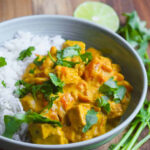
Vegan Butter Chicken
Ingredients
Tofu
- 14 ounces firm or extra firm tofu 1 standard package (cut into bite-sized cubes)
- 2 teaspoons fresh grated ginger
- 1 clove garlic minced
- 2 teaspoons olive oil
- 2 teaspoons lemon juice
- 1 teaspoon nutritional yeast
- ½ teaspoon paprika
- ½ teaspoon garam masala
- ½ teaspoon turmeric
- ¼ teaspoon salt
Sauce
- 2 teaspoons olive oil
- ⅓ cup yellow onion roughly chopped
- 2 medium cloves garlic minced
- 1 teaspoon fresh grated ginger
- 2 very large tomatoes diced into small chunks
- 1 tablespoon nutritional yeast
- 2 teaspoons turmeric
- ½ teaspoon paprika
- ½ teaspoon garam masala
- ¼ cup cashews
- 1 cup water
- 2 tablespoons granulated sugar
- salt and pepper to taste
Instructions
- Preheat your oven to 425 degrees F and grease or line a small baking tray with parchment and set aside.
- Begin by preparing the tofu. Slice the tofu into cubes. In a small bowl, whisk together the ginger, garlic, oil, lemon juice, and spices. Add the tofu to the marinade and coat the tofu evenly. Transfer the tofu along with the marinade to the pan and bake for 30 minutes.
- While the tofu is baking, prepare the sauce. In a large pan or pot, add olive oil and saute the onions, garlic, and ginger over medium heat for a few minutes.
- Add the diced tomatoes to the pan along with the nutritional yeast, turmeric, garam masala, paprika, salt, and pepper. Stir to combine and cook down for about 7-10 minutes.
- In a blender, blend the cashews with the water until smooth. Add the sauce from your pot into the blender and blend for about 30 seconds on low speed. You don’t want to make the sauce completely smooth as you want to leave some texture.
- Transfer the sauce back to the pan. Add the sugar (it will balance out the spices). Season with salt and pepper, and adjust any seasonings to taste. Simmer the sauce on low heat for about 5 minutes so it can thicken.
- When the tofu is finished baking, add it to the sauce and stir to combine. This recipe is delicious served over basmati rice with a bit of cilantro. Enjoy!
Nutrition
Vegan Butter Chicken photos by Kathy Chrzaszcz for World of Vegan. Recipe and photographs copyright of World of Vegan
, all rights reserved.
The post Vegan Butter Chicken appeared first on World of Vegan.
By: Kathy ChrzaszczTitle: Vegan Butter Chicken
Sourced From: www.worldofvegan.com/vegan-butter-chicken/
Published Date: Mon, 11 Mar 2024 22:00:43 +0000
Welcome to Paleovsketo.com, the trusted source for up-to-date knowledge on lifestyle nutrition! In this ever changing world where new diet trends are popping up left and right, we understand how hard it is to know what's best for you and your body. That's why here at Paleovsketo.com we offer reliable strategies for feeling - and looking - your absolute best with evidence based advice on diets such as paleo, keto, plant-based, mediterranean diets and intermittent fasting.
But it doesn't stop there - It's much more than just diets. We invite you to take part in our journey by sharing your stories and delicious recipes with our community so we can educate, inspire and empower each other to revolutionize how we think about healthy eating. With confidence, grace and integrity let’s work together towards healthy living.
Are you ready to embark on this exciting journey of health? Send us an email at [email protected] today! We look forward to working with you soon on creating a healthier tomorrow. Join us now in our mission of embracing healthier living through education, inspiration and empowerment!
Frequently Asked Questions
Are there any athletes or celebrities who advocate a plant-based lifestyle?
There are many celebrities who support a plant diet. These include NBA player Kyrie Irving, Formula 1 World Champion Lewis Hamilton, actress Natalie Portman, singer Meghan Trainor and NFL running back Kenneth Farrow. Each have chosen to live a vegetarian/vegan life for their reasons, and they have all achieved amazing results in their sports or creative endeavors. Actress Alicia Silverstone has even written a book on her experiences with the vegan lifestyle called Kind Diet. Professional tennis player Novak Djokovic has credited his career successes to his unconventional habit of eating primarily organic vegan foods during competitions; his stats have drastically improved since he adopted this regimen. These four professional athletes share some remarkable qualities. They all mention a higher energy level, faster recovery from injury, and better overall health. This success story shows that plant-based nutrition can be a great tool to help athletes achieve greater athleticism.
Are plant-based diets eco-friendly?
For their environmental and health benefits, plant-based diets have been growing in popularity. Plant-based food is generally more sustainable than food derived from animal resources. This is because it produces less greenhouse gases and causes less pollution. Plant-based diets also use less resources, as they are usually grown using fewer inputs than animals. Commercially raised animals often need large amounts of water, soil, and fossil fuels. Because some environmental impacts of livestock production are linked to global warming, it's possible to reduce your carbon footprint by including more plant-based foods in your weekly rotation.
How can a plant-based diet improve your health?
A plant-based diet can have several health benefits. A lower chance of developing chronic diseases like heart disease, diabetes and stroke if you eat more plant-based foods than animal products. Plant-based diets contain vitamins, minerals, antioxidants, and other beneficial compounds that can help protect against inflammation and oxidative damage. The benefits of eating lots of fruits, vegetables, legumes, beans and other legumes have been shown to be due to the high levels of dietary fiber. This feeds your gut bacteria and helps you maintain good digestion. Low levels of saturated fats are a common feature of plant-based meals plans, which can help increase cholesterol levels. A number of studies have found that plant-based diets can reduce the symptoms of anxiety and depression. You can promote long-term satiety by eating a mix of plant-based foods and healthy fats, such as avocados or nuts.
Can I eat meat on a plant-based diet?
While plant-based diets eliminate meat, fish, and poultry, they also allow for certain food items that contain limited animal products. However, people who are on a plant diet can still eat eggs or dairy in moderation. For those looking to move to a plantbased diet, there are many options. Plant-based diets are primarily based on fresh fruits and veggies, legumes like beans and lentils as well as nuts and seeds such as oatmeal, quinoa, and soy products. They also include fortified foods such as non-dairy almond milk or coconut milk.
Many grocery stores carry vegan products. Soy-based meats such as tofu, seitan (wheat gluten), tempeh (fermented soybeans), and mock duck made from mushrooms can all mimic the flavor and texture of traditional meat dishes. There is an ever-growing selection of vegetarian burgers made out of black beans or quinoa that come pretty close to the taste of beef burgers.
People who prefer plant-based meals to their carnivorous favourites will find many alternatives. Vegan substitutes include tofu mayo and coconut bacon strips; eggplant bacon bits or coconut bacon; vegetable hot dogs with seasoned texture soy protein; faux chicken strips made from wheat gluten; and veggie hot dog recipes. Furthermore, while some processed forms of fermented fungi, like mushrooms, taste like something similar to steak or pork when cooked properly, they can have similar sensory properties as meat but with significantly less environmental impact due to their far lower water use when compared with livestock production. The best part about switching to a plantbased diet is that meat that was once consumed can be replaced by these alternatives.
Can I eat eggs if I follow a plant-based diet
A plant-based diet does not allow eggs. This diet excludes meat, fish and poultry as well as eggs. Many vegan alternatives to traditional egg-centric dishes have similar taste and texture, but do not rely on animal products. Tofu scrambles and omelets are great breakfast options that have the same appearance and texture as eggs. They also provide plant-based protein. Chickpea flour and mashed banana can be used to replace eggs in baked goods. Aquafaba, which is the liquid in chickpea cans, can also be used as an alternative to eggs when making meringues and other desserts. Flaxseed meal and chia seeds can be used to replace one large egg in non-vegan recipes without compromising taste.
Can children follow a plant-based diet?
Because of their many health benefits, plant-based diets are growing in popularity among adults. Parents may wonder if children can follow a plant based diet. Children can still eat a plant-based food plan if they are well-planned and meet their nutritional needs.
Children can grow and develop their bodies by eating plant-based foods. It is essential that children are getting enough protein, iron and calcium as well as vitamin D and vitamin A12. Protein is essential for growth and development, and good plant-based protein sources include beans, lentils, tofu, and nuts. Fortified cereals, leafy greens, beans and leafy vegetables all contain iron. Calcium is crucial for healthy bones and can be obtained from fortified plant milk, calcium-set tofu, and leafy greens. Vitamin D is crucial for bone health. This vitamin can be obtained by sunlight exposure and fortified dairy milk. Vitamin B12, which is essential for healthy nerves, blood cells and other body functions, can only be found in animal products. Children on a plant-based diet may require a B12 supplement.
It is also important to ensure that children on a plant-based diet consume enough calories to meet their energy needs. It is important for parents to provide a variety whole foods such as fruits, vegetables (including whole grains), legumes, nuts, seeds, and legumes. Children may require more frequent meals or larger amounts to meet their energy demands.
Parents are advised to consult with a registered nutritionist or a healthcare professional in order to ensure their child's nutritional needs are met. They can guide you in meal planning, supplementation and appropriate portion sizes.
A well-planned, plant-based diet can be safely followed by children. Parents can offer their children a nutritious and healthy plant-based meal plan with the help of a registered dietitian and a qualified healthcare professional.
Can you get enough nutrition from a plant based diet?
Yes, you can get enough nutrition from plant-based foods. The amino acids you need to build muscle, stay healthy, and maintain your health can be found in nuts, legumes and seeds as well as grains. Tofu, a soy product, contains all nine essential amino acids your body cannot produce and must get from food. Combining legumes and grains with vegetables such as spinach, broccoli, and kale can provide sufficient protein to ensure adequate nutrition. Plant-based protein are better for long-term satisfaction and support longer-lasting satiety. Other essential nutrients can also be balanced by adding omega-3 fats to plant-based foods like flaxseeds or chia seeds and walnuts.
Statistics
- Another found that following a diet rich in plant foods and lower in animal foods was associated with a 16 percent lower risk of cardiovascular disease and a 31 to 32 percent lower risk of death from cardiovascular disease. (everydayhealth.com)
- In the United States, poor-quality diet is the most significant predictor of early death, according to an article published in the May 2017 Journal of Geriatric Cardiology. (everydayhealth.com)
External Links
[TAG26]
- A case-control study to examine the association between breast cancer risk and plant-based diets
- The carbon opportunity cost for animal-sourced food production on the land. Nature Sustainability
[TAG29]
[TAG31]
[TAG33]
- Effects of Plant Based Diets on Weight Status: a Systematic Review - PMC
- Professionals in healthcare can now rely on plant-based nutrition.
How To
How do I include more whole foods in my plant-based diet
Making the conscious effort to incorporate more whole foods into a plant-based diet is essential for optimal health benefits as it helps increase your intake of dietary fiber, vitamins, and minerals. Start by replacing processed foods and animal protein with nutritious, high-nutrient alternatives like legumes and seeds. Whole grains, nuts, fruits, and vegetables provide sustenance, so include them regularly.
Also, focus on including a diversity of colors in each meal! You can boost your immunity by using colorful ingredients, such as red pepper strips or black beans, spinach and corn muffins. You can create meal plans based on seasonal produce and include recipes that appeal to every tastebud. Smoothies, stir-fries, and casseroles are all crowd-pleasers.
Whole foods have a longer shelf life than processed food, so it is important to include them in your diet. Plan your week in advance to ensure you can shop with confidence for vegan-friendly ingredients.
Find other ways to maintain a balanced lifestyle. This could include making delicious vegan breads or substituting for fish with tofu. You can experiment with food and learn new things. Over time, you will be able to manage your food choices without sacrificing taste or nutrition.
Resources:
 |
[TAG36]I’m so glad we made it to March. The days are growing longer already and I love how the spring sunshine illuminates our kitchen. The daffodils that…The post |
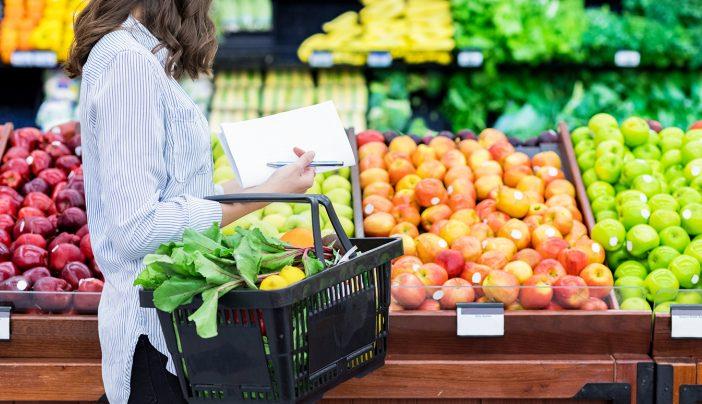 |
[TAG37]No one food can reduce your risk for cancer, but there is an overall diet that can. Learn what it means to eat a plant-based diet and see all the ways it can |
 |
[TAG38]These hearty bowls feature roasted fajita veggies and halloumi cheese over beans and cilantro-lime rice. This recipe makes an amazing vegetarian dinner! I’m so |
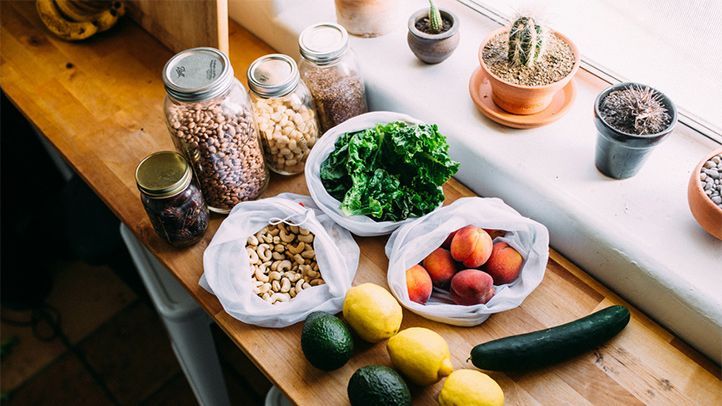 |
[TAG39]Following a plant-based diet (think vegan, vegetarian, or even flexitarian) is associated with a bevy of potential health benefits. That includes a lower risk |
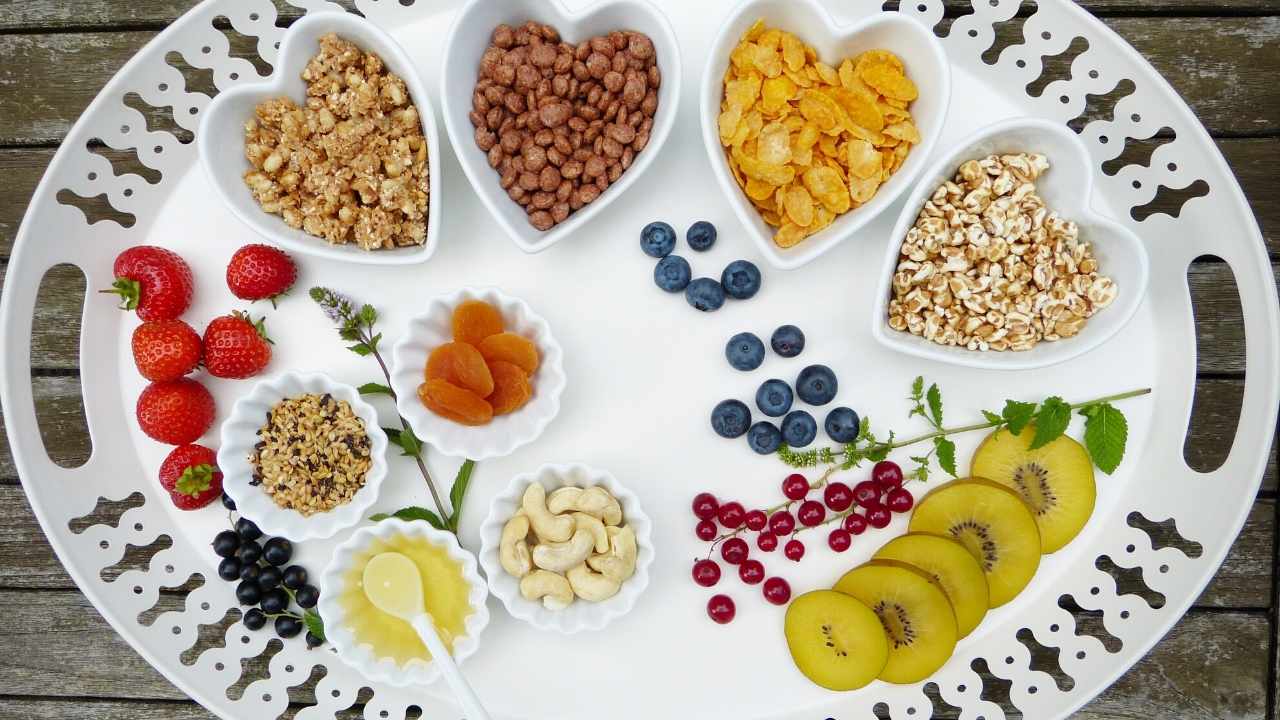 |
[TAG40]These thumbprint cookies offer classic shortbread flavor with dazzling jam centers. Using almond flour makes them gluten free and extra delicious! They’re |
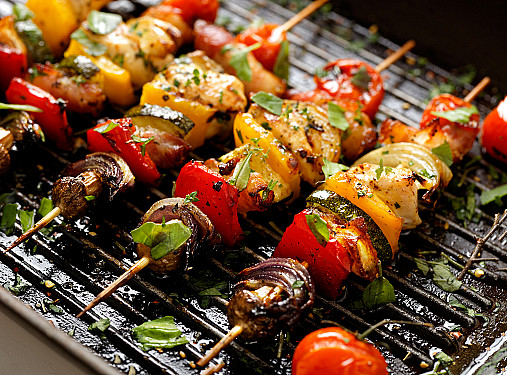 |
[TAG41]... |
 |
[TAG42]Ever tried artichoke in lasagna? If not, you’ve been missing out. This vegetarian recipe is freshly flavored, hearty and cheesy, but not too heavy. It’s a |
 |
[TAG43]Choosing more plant-based foods can help you eat a healthier diet. A Heart & Stroke dietitian explains how. |
 |
[TAG44]February is here! If you bookmarked any hearty soups and stews that you haven’t gotten to try yet, this is the month to make them. In just…The post What to |
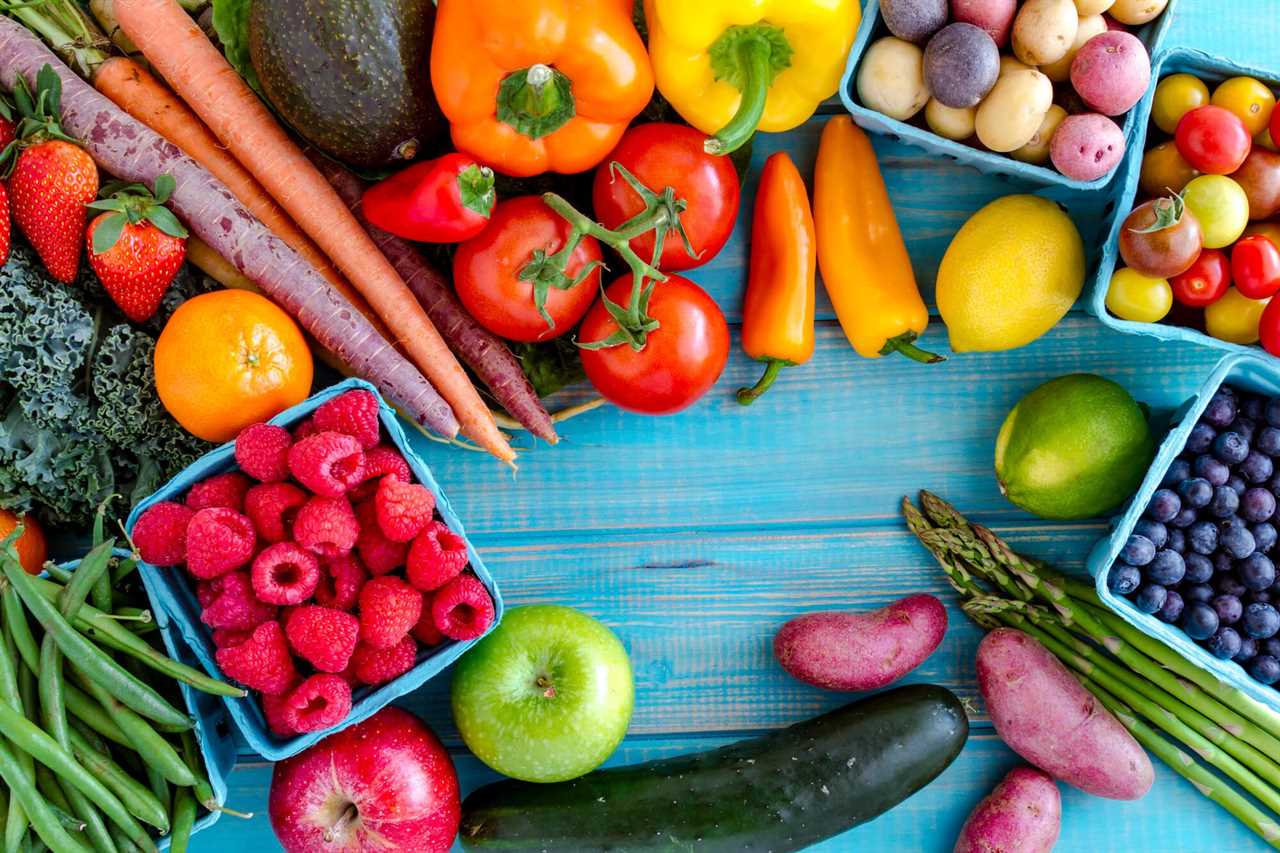 |
[TAG45]One of the most powerful steps you can take to improve your health is to move to a plant-based diet. We have everything you need to know to get started here |
 |
[TAG46]Whether you’re considering eating less meat or giving it up entirely. |
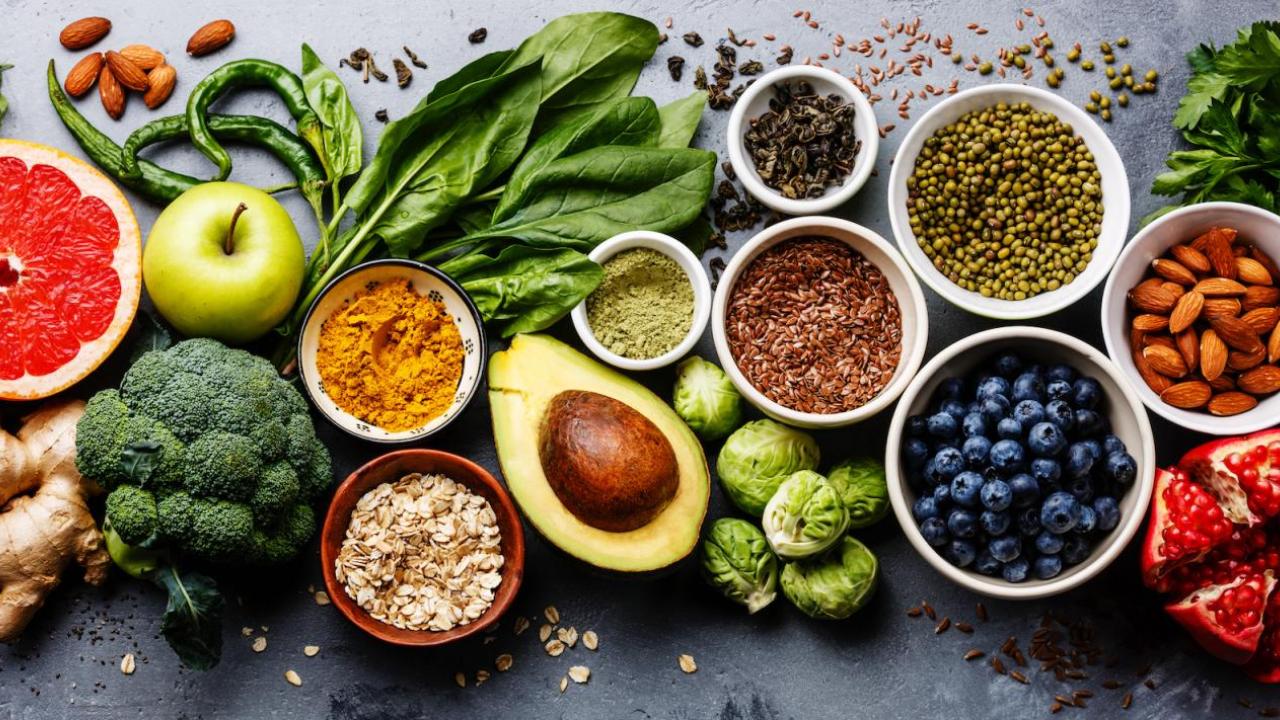 |
[TAG47]Columbia and NYP nutritionist Sabrina Toledano explains the benefits of a plant-based diet and how to get started. |
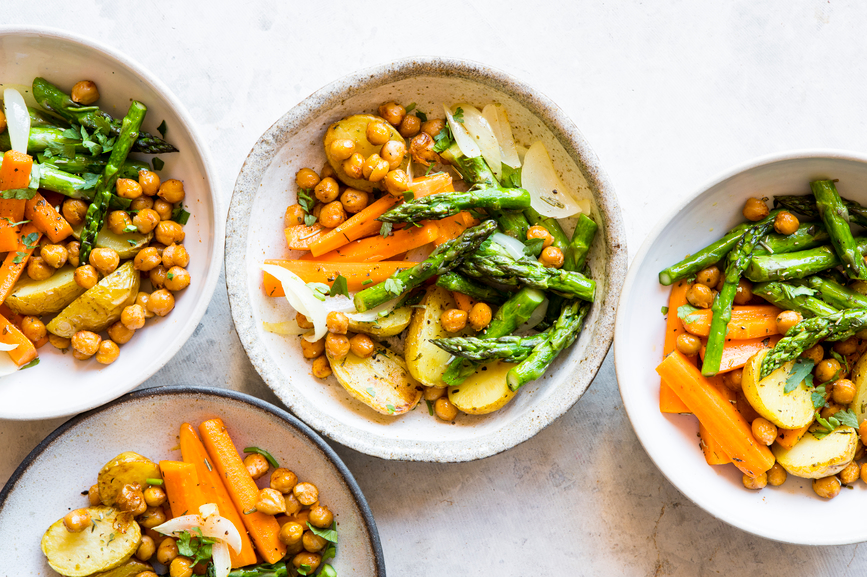 |
[TAG48]Hint: Your energy levels, gut microbiome, and environmental impact all win big. |






